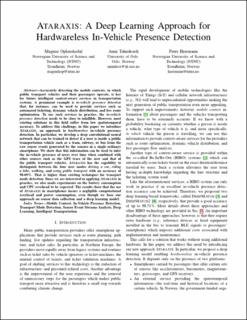| dc.contributor.author | Oplenskedal, Magnus Karsten | |
| dc.contributor.author | Taherkordi, Amirhosein | |
| dc.contributor.author | Herrmann, Peter | |
| dc.date.accessioned | 2023-02-21T09:01:12Z | |
| dc.date.available | 2023-02-21T09:01:12Z | |
| dc.date.created | 2022-12-29T16:26:07Z | |
| dc.date.issued | 2021 | |
| dc.identifier.isbn | 978-1-6654-1621-4 | |
| dc.identifier.uri | https://hdl.handle.net/11250/3052609 | |
| dc.description.abstract | Accurately detecting the mobile contexts, in which public transport vehicles and their passengers operate, is key for future intelligent context-aware services in transportation systems. A prominent example is in-vehicle presence detection that, for instance, can be used to provide services such as automated ticketing, dynamic vehicle distribution, and live route optimization. To use such services in practice, the in-vehicle presence detection needs to be close to infallible. However, most existing solutions in this field suffer from low spatiotemporal accuracy. To address this challenge, in this paper we introduce ATARAXIS, an approach to hardwareless in-vehicle presence detection. In particular, we develop a deep convolutional neural network that can be trained to detect if a user is inside a public transportation vehicle such as a tram, subway, or bus from the raw sensor events generated by the sensors in a single ordinary smartphone. We show that this information can be used to infer the in-vehicle presence of users over time when combined with other sources such as the GPS trace of the user and that of the public transport vehicles. ATARAXIS has the capability to distinguish between the four user modes driving a car, riding a bike, walking, and using public transport with an accuracy of 98.69%. That is higher than existing techniques for transport mode detection. Since we are interested in applying ATARAXIS in practice, we also made experiments on the battery consumption and CPU overhead to be expected. The results show that the use of ATARAXIS in smartphones incurs a negligible computational overhead and power consumption, even though we base our approach on sensor data collection and a deep learning model. | en_US |
| dc.description.abstract | Ataraxis: A Deep Learning Approach for Hardwareless In-Vehicle Presence Detection | en_US |
| dc.language.iso | eng | en_US |
| dc.publisher | IEEE | en_US |
| dc.relation.ispartof | IEEE International Conference on Cognitive Machine Intelligence (CogMI) | |
| dc.relation.uri | https://ieeexplore.ieee.org/document/9750321 | |
| dc.title | Ataraxis: A Deep Learning Approach for Hardwareless In-Vehicle Presence Detection | en_US |
| dc.title.alternative | Ataraxis: A Deep Learning Approach for Hardwareless In-Vehicle Presence Detection | en_US |
| dc.type | Chapter | en_US |
| dc.description.version | acceptedVersion | en_US |
| dc.rights.holder | © IEEE. Personal use of this material is permitted. Permission from IEEE must be obtained for all other uses, in any current or future media, including reprinting/republishing this material for advertising or promotional purposes, creating new collective works, for resale or redistribution to servers or lists, or reuse of any copyrighted component of this work in other works. | en_US |
| dc.source.pagenumber | 17-26 | en_US |
| dc.identifier.doi | 10.1109/CogMI52975.2021.00012 | |
| dc.identifier.cristin | 2098048 | |
| cristin.ispublished | true | |
| cristin.fulltext | postprint | |
